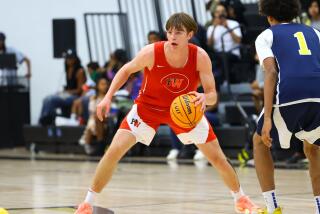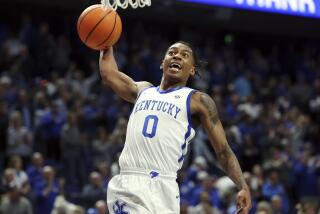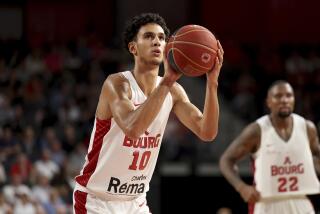NBAâs Age Limit Is Developing Situation
A new day is dawning in basketball, but nobody can tell what it looks like yet.
âI went to bed last night not knowing exactly what the rule was,â North Carolina Coach Roy Williams said Wednesday.
The NBA plan to essentially raise the minimum age by one year, to 19, as part of a new collective-bargaining agreement could make the one-and-done college player commonplace, turn prep schools into fifth-year stopovers for high school players, introduce young superstars to the previously inconsequential NBA development league or send 18-year-olds job-hunting overseas.
Or not.
For now, everyone is guessing.
âPrep school is going to be the next big thing,â said Antonio Fozard, coach at Mount Zion Christian Academy in Durham, N.C., where Tracy McGrady played his senior season before turning pro.
âThose who qualify and are eligible will probably go to college. If youâre not eligible, youâll see a lot of kids go to prep school.â
Others believe the rule will be a boon to the NBDL, where players will earn perhaps $24,000 -- plus whatever they can get from agents and endorsements based on their NBA future.
âI think in three or four years youâll see on the cover of Sports Illustrated an NBDL kid,â said David Kahn, the former general manager of the Indiana Pacers and leader of a group of investors who bought four NBDL expansion teams in Fort Worth and Austin, Texas, Tulsa, Okla., and Albuquerque.
Kahn envisions a minor-league system that resembles baseballâs, where fans can catch a rising star and players can grow up a little on and off the court -- particularly those who donât want to go to college or donât have the option.
âI hope it doesnât sound at all pejorative, but certain kids donât have interest in college -- and again, not to be pejorative, but a lot have attended college who did not belong in college but knew it was a necessary step to a pro career,â Kahn said.
Or, as Fozard sees it: âWhen you get into college life, you have the NCAA, a lot of rules and regulations, doâs and canât doâs. Some high school players would rather go to prep school.â
The new age limit was a big topic of discussion Wednesday at a camp at the University of Virginia that featured many of the top high school players in the nation.
Taylor King, who will be a junior at Mater Dei next season, has problems with the rule.
âI think itâs unfair to players who are good enough,â he said.
Many college coaches worry about college becoming a whistle stop, but Williams -- who lost Rashad McCants, Raymond Felton, Sean May and freshman Marvin Williams early to the NBA draft from this yearâs NCAA championship team -- said in some cases it already is.
He changed his recruiting philosophy years ago: He already tries to recruit a mix of the most talented players and those he believes will stay four years.
One of Williamsâ worries is the academic attitude one-year players might adopt.
âI canât have anybody lounging in the dorm room second semester thinking this is a minor league farm system,â Williams said.
âThereâs no question itâs something to be concerned about,â he said. âIâm going to look in the eyes of every player, every mom and dad and say, âI donât care if youâre here one, two, three or four years, when youâre here youâll be expected to be very serious about academics.â
âI have no problem holding a guy out of a game, whether itâs the national championship game or any game.â
Interestingly, one reason not to go to college for a year could be the possibility it would undermine a playerâs draft status.
âCollege exposes a lot of kids,â Fozard said. âI have had some high school players who might have been first round but chose to go to college.â
Against stronger competition, the difference between seeming potential and actual ability becomes clear.
Martin Iti, a much-traveled former Mount Zion player who once was considered an NBA prospect, was a disappointment at North Carolina Charlotte and recently transferred to New Mexico State. He is long since off the NBA radar.
Williams considers the possibility a player will recognize how much he needs to improve to play in the NBA one of the positives of the rule change.
Overall, he called the NBA decision âwindow-dressing.â
âWhat bothers me is thereâs almost a stigma if a rising senior is still in college, like, âWhatâs wrong with him?â â he said. âNow they just moved it down to sophomores.â
But itâs out of his hands.
âIâm not one of the guys speaking of the legions of doom. It hit us hard this year, but each individual did whatâs best for them,â Williams said.
âIâm not pie in the sky. ... The NBA, thatâs not their job to try to help college basketball. They did the best for their game.â
Times staff writer Eric Sondheimer contributed to this report.
*
(BEGIN TEXT OF INFOBOX)
Early Out
A record eight high school players were selected in the first round of the 2004 NBA draft. High school players eligible for Tuesdayâs draft:
*--* Player School Ht. Andray Blatche S. Kent Prep 6-11 Curtis Brown Jr. Beach (Ga.) 6-9 Andrew Bynum St. Josephâs (N.J.) 6-11 Monta Ellis Lanier (Miss.) 6-3 Gerald Green Gulf Shores Acad. (Texas) 6-8 Amir Johnson Westchester 6-10 Kyle Luckett South Side (Ind.) 7-0 C.J. Miles Skyline (Texas) 6-6 Ricky Sanchez IMG Academy (Fla.) 6-10 Martell Webster Seattle Prep 6-7 Louis Williams South Gwinnett (Ga.) 6-3
*--*
*
NBA DRAFT FACTS
* When: Tuesday, 4 p.m. PDT, ESPN. * Where: Madison Square Garden, New York
* Laker draft picks: No. 10 (first round); Nos. 37, 39 (second round).
* Clipper draft picks: No. 12 (first round); Nos. 32, 42 (second round).
More to Read
Go beyond the scoreboard
Get the latest on L.A.'s teams in the daily Sports Report newsletter.
You may occasionally receive promotional content from the Los Angeles Times.










